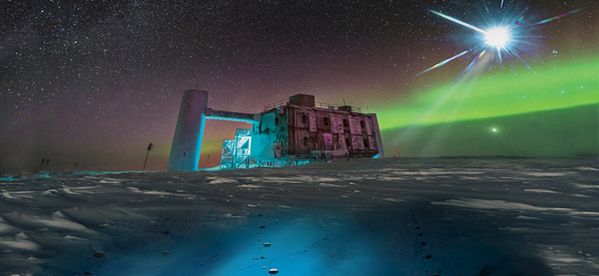IceCube Collaboration awarded 2021 Bruno Rossi Prize
The international IceCube Collaboration, which includes several researchers from Michigan State University, was awarded the 2021 Bruno Rossi Prize by the High Energy Astrophysics Division of the American Astronomical Society (AAS), for the discovery of a high-energy neutrino flux of astrophysical origin.

MSU experimental high energy physicists Claudio Kopper, and Nathan Whitehorn, were the two lead authors of the 2013 analysis that discovered the neutrino flux for which IceCube received the Rossi prize.
Neutrinos are tiny, nearly massless particles that can travel at near light speeds —unperturbed. Often called “ghost particles” and notoriously difficult to locate, neutrinos are one of the universe’s essential ingredients, and have played a role in helping scientists understand some of the most fundamental questions in physics.
Because neutrinos can travel for billions of light-years through space, they can uniquely provide accurate information about the distant universe.
The IceCube Neutrino Observatory (IceCube) is a cubic-kilometer particle detector made of Antarctic ice located near the Amundsen-Scott South Pole Station. It is the first gigaton neutrino detector ever built and was primarily designed to observe neutrinos from the most violent astrophysical sources in our universe.
Highly energetic neutrinos that come from beyond our solar system are known as astrophysical neutrinos and are the main focus of IceCube’s research. Identifying astrophysical sources of these particles, called cosmic accelerators, is one of the scientific goals of IceCube.
An international group of scientists responsible for IceCube’s scientific research constitutes the IceCube Collaboration. It includes more than 300 researchers from 53 institutions in 12 countries, four of whom are from MSU.
Kopper and Whitehorn are currently the joint leaders of the Diffuse and Atmospheric Flux Working Group in the IceCube Collaboration responsible for much of the science related to the discovery of the neutrino flux.

“I feel very honored that the IceCube collaboration received the Bruno Rossi Prize this year,” said Kopper, associate professor, Department of Physics and Astronomy. “Being part of the collaboration and having been involved in the discovery itself is something I am very proud of.
“IceCube has always been a great collaboration of incredible people,” added Kopper, “but it became especially clear how well this collaboration works back when we saw the first highest-energy cascade events in our data. We came together to design a new analysis strategy from the ground up to find more of these events — something that eventually led to us being able to claim a >5-sigma discovery of an astrophysical flux. Ever since then, IceCube has been adding more and more pieces to the ever-evolving puzzle of the astrophysical neutrino flux and its sources, discovering source candidates such as TXS 0506+056 and hopefully many more in the future.”

“In the fall of 2012, we finished the analysis of the first dataset that provided really solid evidence of the astrophysical neutrino background,” said Whitehorn, assistant professor, Department of Physics and Astronomy. “As our computers processed the data and found each likely astrophysical neutrino, it would pop it up on a screen in our conference room; we expected under ten by chance. When the number passed around 15, we all realized that this was our first glimpse—at first, just for those of us in the room—of something all around us that no one had ever seen before; it was incredibly exciting.
“Eight years later, we are just beginning to understand where astrophysical neutrinos come from, both deepening the puzzle and making the first astronomical discoveries," he continued. "Receiving the Rossi prize from the AAS is a great honor and a milestone in realizing the dreams of everyone who built and worked on IceCube to turn neutrinos into the powerful tool to understand the high-energy universe that it is today.”
In addition to Kopper and Whitehorn, the MSU IceCube team includes Darren Grant (IceCube Collaboration spokesperson), Tyce DeYoung, Kirsten Tollefson and Kendall Mahn—a team that collectively studies all research aspects of the multifaceted IceCube facility, from the fundamental properties of the neutrino to the most extreme astrophysical objects in the universe producing the highest energy neutrinos ever recorded.
“Science research requires many things to succeed,” said Stephen Zepf, Department of Physics and Astronomy chair, “but most projects succeed because of the hard work of excellent people. The IceCube project is no exception, and it is great to see all of the MSU physicists on IceCube being recognized with the Rossi Prize being awarded to the project.”
Named after Italian experimental physicist Bruno Rossi—who made major contributions to particle physics and the study of cosmic rays, launched the field of X-ray astronomy, and discovered the first X-ray source, the Rossi Prize is awarded for a significant contribution to high energy astrophysics, with particular emphasis on recent, original work.
Banner image: The IceCube Neutrino Observatory (IceCube) is a cubic-kilometer particle detector made of Antarctic ice located near the Amundsen-Scott South Pole Station. It is the first gigaton neutrino detector ever built and was primarily designed to observe neutrinos from the most violent astrophysical sources in our universe. Credit: IceCube Observatory